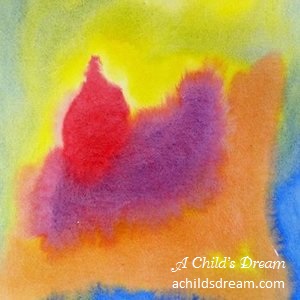

Waldorf Wet-on-Wet Watercolor Painting
I loved painting with my children and their friends and am now doing it with my grandchildren. Painting on damp paper enables us to see and experience the flowing nature of color. Children as young as two and three can handle a paintbrush and become immersed in the process. Imaginations become active as scenes and objects are discovered in the painting.
I recommend you and your child/children paint together at least once a week on the same day, incorporating it into your weekly rhythm. Rather than beginning with a specific idea of what to paint, simply experience the color one at a time at first and allow the picture to emerge from the painting thus encouraging flexibility and imagination.
Introducing the colors:
For the youngest (2-3 years of age) it is recommended to begin with one color at a time until all three primary colors (carmine red, lemon yellow and ultramarine or prussian blue) have been thoroughly experienced. Then (3-6 years of age), progress to 2 primary colors at a time until all combinations have been used (red & blue, yellow and blue, yellow and red) - observing how two colors create a third and what forms are created on their paper. School age children (7 and up) will enjoy using all three primaries at once. This is also a good age to add the 3 additional colors offered.
Materials needed:
You’ll find the recommended paint and supplies in our Arts & Crafts Painting Section.
- Paints - primary colors carmine red, ultramarine or prussian blue and lemon yellow. The 50 ml. size of Stockmar Watercolor Paint concentrates is enough for a year if painting weekly or working with a large group.
- Brushes - one for you and one for each child. Ideally you will be painting with your child. This helps maintain focus and allows you to set the pace and teach by example. I like to begin with a 1” to 1-1/2” brush for the 2-6 year olds; older children can handle a smaller brush, 1//2" - 3/4".
- Paper - heavy weight (140 lb), cold press watercolor paper.
- Jars - for mixing and storing paints. You can reuse clean baby food jars or other small jars with a wide mouth. Later, you might add a jar holder with matching sized jars to help keep order and give the paint pots a "home" on the table.
- Water Jar - for rinsing brushes
- Table Protection - waterproof table cloth or similar. Your table WILL get wet.
- Other - Clean sponge for soaking up excess water on paper prior to painting; a clean, cotton cloth like a piece of an old t-shirt or diaper for blotting your brush; and an apron or old shirt to wear to keep paint off your clothes.
You can soak the paper in your sink if it’s wide enough or a plastic sweater tub/box which could also be used to store supplies afterwards.
A painting board is not necessary, we never used one, however painting on one does allow you to move the painting somewhere else to dry, otherwise it will have to remain on your protected table until the risk of the paint running has passed. We painted on our kitchen table and did our painting session a few hours before we had to clear it for a meal.
Preparing and Painting:
- Cut your sheet to desired size and round off the corners with scissors. Soak paper in water for 20–30 minutes while mixing your paints.
- Put a few tablespoons of water in a clean jar then add Stockmar Watercolor Paint, starting with ½ teaspoon and adding more to deepen the color. Mix well.
- After the paper has soaked remove it from the water and hold over the sink or tub letting it drip a bit then place it textured side up on a flat surface such as a table covered with a plastic cloth, a paint board or a piece of masonite. Avoid making air bubbles. Use sponge or cloth to wipe off excess water and flatten any bubbles that form.
- Painting while seated helps maintain focus.
You’re ready to paint! It’s so enjoyable to watch as the color spreads out over the surface of the wet paper. Be sure to rinse the paintbrush well in the jar of water before using another color. When finished, keep the painting flat until dry.
Hint:
Children especially draw inspiration from hearing imaginative, colorful verses, short fairy tales, fables or Main Lesson stories just prior to the painting process. Remember to refrain from suggesting painting subjects. Let the image reveal itself and transform as the paint is applied to and moves on the paper.
Care of your supplies:
Paintbrushes can be rinsed clean in cold water. They will last longer if hung to dry, stored in a dry jar bristles up or laid flat. They should not be cleaned with detergent or hot water as this can cause loosening of the bristles. Do not leave them bristle side down in the jar as this will bend the bristles.
Diluted paints can be stored in their mixing jars with the lids on. If stored in a cool place, like the back of your refrigerator, they will last until you use them up. Concentrated pigment will settle on the bottom of the jar and can be mixed back in or used “straight” for areas where darker color is desired.
As far as any trepidation you might be feeling about painting or any negative art experiences that might come up for you from your past, be kind to yourself and start anew, as if a child!
~ Deborah Staggs
Paintings by Ann Neal-Levi, teacher at the Whatcom Hills Waldorf School
